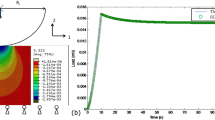Abstract
Instrumented nanoindentation experiments, especially with sharp tips, are a well-established technique to measure the hardness and moduli values of a wide range of materials. However, and despite the fact that they can accurately delineate the onset of the elasto-plastic transition of solids, spherical nanoindentation experiments are less common. In this article we propose a technique in which we combine (i) the results of continuous stiffness measurements with spherical indenters–with radii of 1 μm and/or 13.5 μm, (ii) Hertzian theory, and (iii) Berkovich nanoindentations, to convert load/depth of indentation curves to their corresponding indentation stress–strain curves. We applied the technique to fused silica, aluminum, iron and single crystals of sapphire and ZnO. In all cases, the resulting indentation stress–strain curves obtained clearly showed the details of the elastic-to-plastic transition (i.e., the onset of yield, and, as important, the steady state hardness values that were comparable with the Vickers microhardness values obtained on the same surfaces). Furthermore, when both the 1 μm and 13.5 μm indenters were used on the same material, for the most part, the indentation stress–strain curves traced one trajectory. The method is versatile and can be used over a large range of moduli and hardness values.
Similar content being viewed by others
References
W.C. Oliver, G.M. Pharr: Measurement of hardness and elastic modulus by instrumented indentation: Advances in understanding and refinements to methodology. J. Mater. Res. 19, 3 (2004).
D. Tabor: Hardness of Metals (Clarendon Press, Oxford, 1951).
X. Li, B. Bhusan: A review of nanoindentation continuous stiffness measurement technique and its applications. Mater. Charact. 48, 11 (2002).
J.S. Field, M.V. Swain: The indentation characterisation of the mechanical properties of various carbon materials: Glassy carbon, coke and pyrolytic graphite. Carbon 34, 1357 (1996).
J.S. Field, M.V. Swain: Determining the mechanical properties of small volumes of material from submicrometer spherical indentations. J. Mater. Res. 10, 101 (1995).
J.E. Bradby, J.S. Williams, M.V. Swain: Pop-in events induced by spherical indentation in compound semiconductors. J. Mater. Res. 19, 380 (2004).
E.G. Herbert, G.M. Pharr, W.C. Oliver, B.N. Lucas, J.L. Hay: On the measurement of stress-strain curves by spherical indentation. Thin Solid Films 398–399, 331 (2001).
N. Iwashita, M.V. Swain, J.S. Field, N. Ohta, S. Bitoh: Elasto-plastic deformation of glass-like carbons heat-treated at different temperatures. Carbon 39, 1525 (2001).
N. Iwashita, J.S. Field, M.V. Swain: Indentation hysteresis of glassy carbon materials. Philos. Mag. A 82, 1873 (2002).
J.S. Field, M.V. Swain: A simple predictive model for spherical indentation. J. Mater. Res. 8, 297 (1993).
J.E. Bradby, S.O. Kucheyev, J.S. Williams, C. Jagadish, M.V. Swain, P. Munroe, M.R. Phillips: Contact-induced defect propagation in ZnO. Appl. Phys. Lett. 80, 4537 (2002).
S.O. Kucheyev, J.E. Bradby, J.S. Williams, C. Jagadish, M.V. Swain: Mechanical deformation of single-crystal ZnO. Appl. Phys. Lett. 80, 956 (2002).
A. Murugaiah, M.W. Barsoum, S.R. Kalidindi, T. Zhen: Spherical Nanoindentations in Ti3SiC2. J. Mater. Res. 19, 1139 (2004).
M.W. Barsoum, A. Murugaiah, S.R. Kalidindi, T. Zhen: Kinking nonlinear elastic solids, nanoindentations and geology. Phys. Rev. Lett. 92, 255508-1 (2004).
M.W. Barsoum, A. Murugaiah, S.R. Kalidindi, Y. Gogotsi: Kink bands, nonlinear elasticity and nanoindentations in graphite. Carbon 42, 1435 (2004).
I.N. Sneddon: The relaxation between load and penetration in the axisymmetric boussinesq problem for a punch of arbitrary profile. Int. J. Eng. Sci. 3, 47 (1965).
B.N. Lucas, W.C. Oliver: Indentation power-law creep of high-purity indium. Metall. Mater. Trans. A 30, 601 (1999).
S. Basu, M.W. Barsoum, S.R. Kalidindi: Sapphire: A kinking nonlinear elastic solid. J. Appl. Phys. 99, 063501 (2006).
U. Ozgur, Y.I. Alivov, C. Liu, A. Teke, M.A. Reshchikov, S. Dogan, V. Aurutin, S.J. Cho, H. Morkoc: A comprehensive review of ZnO materials and devices. J. Appl. Phys. 98, 041301 (2005).
J.B.J Wachtman, W.E. Tefft, D.C.J Lam, R.P. Stenchfield: Elastic constants of synthetic single crystal corundum at room temperature. J. Res. Natl. Bur. Stand. 64A, 213 (1960).
Author information
Authors and Affiliations
Corresponding author
Rights and permissions
About this article
Cite this article
Basu, S., Moseson, A. & Barsoum, M.W. On the determination of spherical nanoindentation stress–strain curves. Journal of Materials Research 21, 2628–2637 (2006). https://doi.org/10.1557/jmr.2006.0324
Received:
Accepted:
Published:
Issue Date:
DOI: https://doi.org/10.1557/jmr.2006.0324




